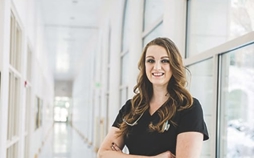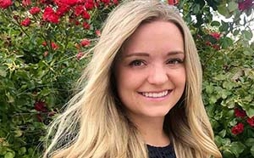“Mini Stroke” Led Student to Nursing
College of Nursing graduate Megan Parr was born with a hole between the top two chambers of her heart, disrupting the flow of blood to her body. This difficulty led her to a career in nursing.
May 2017

Before beginning her freshman year, Megan Parr had everything figured out and was ready to hit the ground running. But she had no idea how much her plans would change before she could even start.
“I was signed up for athletic training pre-requisites, and then I ended up having a transient ischemic attack (TIA), which is like a mini version of a stroke,” said Parr, now a graduate of BYU’s College of Nursing.
Parr was born with an atrial septal defect—a hole between the top two chambers of the heart that disrupted blood flow. Neither she nor her family were aware of it until a blood clot, caused by the disrupted blood flow, went to her brain, causing the TIA and putting her in the hospital.
“It was actually a nurse, not a doctor, who suggested checking my heart out,” said Parr. “All the nurses who took care of me were fantastic and they inspired me to study nursing.”
Parr changed her major as soon as she left the hospital. After completing two years of the nursing program and serving as a full-time missionary for The Church of Jesus Christ of Latter-day Saints in Billings, Montana, Parr was asked by one of her professors, Blaine Winters, to join his research team.
“We wanted the research to be about falls and the elderly, but we needed to narrow it down,” said Parr. “And at that time, I worked at a nursing home, first as a CNA and later on as an LPN, so I knew it was a big problem.”
Specifically, Parr noticed that a common cause of falls was the lack of proper staff education at nursing homes. That’s how their research came to focus on educating the non-nursing staff about falls.
“I realized that there are more people than just CNAs, LPNS, RNs, and physical and occupational therapists who interact with the elderly,” said Parr. “There are dietitians, housekeepers, the maintenance people, recreational people, and secretaries. A lot of times the residents forget who can help them and who can’t and those people don’t know how to properly transfer them.”
Although the project remains a work in progress, Parr was able to finish the literature review and present the team’s findings at the Utah Nurses Association Conference during her senior year. Now, she works as a nurse in the emergency room at Utah Valley Hospital.
“Being involved in research really enhanced the broad spectrum of my education and helped me realize the importance of an evidence-based practice and how it helps create safety,” said Parr. “I think research is the key to a post-baccalaureate education and progress in nursing, so doing it as an undergraduate student put me a step ahead that much quicker.”
Donate to BYU Nursing Give to BYURelated story:

College of Nursing graduate Megan Parr was born with a hole between the top two chambers of her heart, disrupting the flow of blood to her body. This difficulty led her to a career in nursing.

June Leifson says that her career goal of becoming a nurse was the result of more than a score of operations that introduced her to the field of medicine in a personal way.

Bryn Nelson always wanted to be a nurse. When her father died in a tragic accident her career goal took on a whole new dimension.